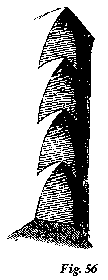DECORATION XXIII. THE EDGE AND FILLET 323
at Bourges, for distant effect, worked into plain leaves, or bold bony processes with knobs at the points, and near the spectator, into crouching demons and broad winged owls, and other fancies and intricacies, innumerable and inexpressible.
§ 11. Thus much is enough 
The whole early architecture of Venice is architecture of incrustation: this has not been enough noticed in its peculiar relation to that of the rest of Italy. There is, indeed, much incrusted architecture throughout Italy, in elaborate ecclesiastical work, but there is more which is frankly of brick, or thoroughly of stone. But the Venetian habitually incrusted his work with nacre; he built his houses, even the meanest, as if he had been a shell-fish,-roughly inside, mother-of-pearl on the surface: he was content, perforce, to gather the clay of the Brenta banks, and bake it into brick for his substance of wall; but he overlaid it with the wealth of ocean, with the most precious foreign marbles. You might fancy early Venice one wilderness of brick, which a petrifying sea had beaten upon till it coated it with marble: at first a dark city-washed white by the sea foam. And I told you before2 that it was also a city of shafts and arches, and that its dwellings were raised upon continuous arcades, among which the sea waves wandered. Hence the thoughts of its builders were early and constantly directed to the incrustation of arches.
§ 12. In Fig. 57 I have given two of these Byzantine stilted arches: the one on the right, a, as they now too often appear, in its bare brick work; that on the left, with
1 [Remarks on the Architecture of the Middle Ages, 1835, p. 196.]
2 [See above, p. 242; and cf. vol. ii. ch. v. § 13.]
[Version 0.04: March 2008]